How to backup and restore Windows 10 applications without software
You should protect your data (not only include documents and photos) by backing them up. The Windows applications and utilities you use also create data, so today's article will show you how to back up and restore them without using any software.
Applications like Maps and Sticky Notes, along with utilities like Registry Editor and printers, contain important settings and customizable data. And surely you don't want to lose them, right?
If you have your own backup tips for Windows tools without additional software, let everyone know in the comment section below!
How to backup and restore Windows 10 applications without software
- General tips on backup
- 1. Windows applications
- 2. Start menu
- Backup the Start menu layout
- Restore the Start menu layout
- 3. Printer
- Back up printer settings
- Store printer settings
- 4. Windows Registry
- Backup Windows Registry
- Restore printer settings
General tips on backup

Data is the lifeblood of a computer and you should take care of it carefully. The methods outlined in this tutorial are great for quickly backing up Windows applications and utilities, but for optimal protection you should always back up your entire system regularly and follow these tips. :
- There are many copies of all data: If you feel uncomfortable when losing data, back it up.
- Use other storage media: Do not keep your backups on the same drive. If the device has a problem, you will lose everything.
- Store an offsite backup: If you keep all your backups physically close together, a natural disaster will ruin it all. Consider using cloud services to easily store offsite data.
1. Windows applications
Many Windows applications store their installation files in AppData folders . Here are a few examples of directory paths.
- Alarms & Clock:
% LocalAppData% PackagesMicrosoft.WindowsAlarms_8wekyb3d8bbwe
- Camera:
% LocalAppData% PackagesMicrosoft.WindowsCamera_8wekyb3d8bbwe
- Groove Music:
% LocalAppData% PackagesMicrosoft.ZuneMusic_8wekyb3d8bbwe
- Maps:
% LocalAppData% PackagesMicrosoft.WindowsMaps_8wekyb3d8bbweSettings
- News:
% LocalAppData% PackagesMicrosoft.BingNews_8wekyb3d8bbwe
- Photos:
% LocalAppData% PackagesMicrosoft.Windows.Photos_8wekyb3d8bbwe
- Remote Desktop:
% LocalAppData% PackagesMicrosoft.RemoteDesktop_8wekyb3d8bbwe
- Sticky Notes:
% LocalAppData% PackagesMicrosoft.MicrosoftStickyNotes_8wekyb3d8bbwe
- Weather:
% LocalAppData% PackagesMicrosoft.BingWeather_8wekyb3d8bbwe
Just press Windows + R key to open Run, enter the desired directory path and click OK. Copy and paste the files elsewhere to create your backups.
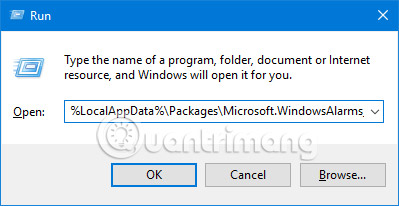
To restore files, go to the application's directory path, paste the backup and click Replace the files at the destination location.
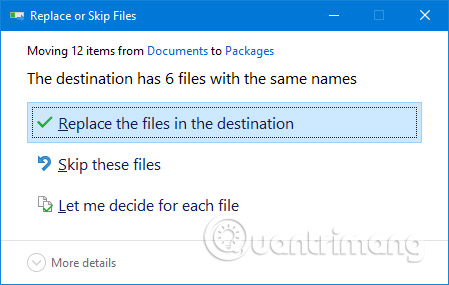
Before you start, make sure the application is fully closed.
2. Start menu
The Start menu on Windows 10 allows for more customization. You can pin programs, organize them into groups and more. You can backup this layout to save reset time.
Backup the Start menu layout
To start, press the Windows + R key to open Run. Enter regedit and click OK. This will open the Registry Editor.
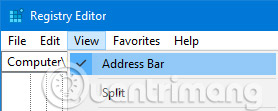
In the toolbar, click View and select Address Bar . Copy and paste the following information into the address bar, then press Enter:
HKEY_CURRENT_USERSoftwareMicrosoftWindowsCurrentVersionCloudStoreStoreCacheDefaultAccount
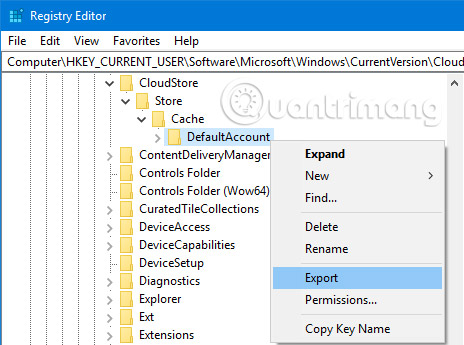
On the left panel, right-click on the DefaultAccount folder and click Export. Navigate to the place you want to save, name the file .reg and click Save. Close the Registry Editor.
Again, press the Windows + R key. Enter % LocalAppData% MicrosoftWindowsShell and click OK. This will open a folder via File Explorer.

In this directory is a file named DefaultLayouts.xml. Copy and paste this file into the same place where you saved the .reg file.
Restore the Start menu layout
To restore from the backup you created earlier, press the Windows + R key combination to open Run, enter regedit and click OK.
Navigate to the same path as before:
HKEY_CURRENT_USERSoftwareMicrosoftWindowsCurrentVersionCloudStoreStoreCacheDefaultAccount
On the left panel, right-click the DefaultAccount folder and click Delete. Click Yes to confirm. Then, close the Registry Editor.

Next, navigate to where you saved the .reg file and double-click it. Registry Editor will ask if you are sure you want to continue. Click Yes and then select OK.
Copy the backup version of the file DefaultLayouts.xml. Press the Windows + R key, enter % LocalAppData% MicrosoftWindowsShell and click OK. Paste the file here. Click Replace the file in the destination location.
Log out, then log back in to your account to complete the process.
3. Printer
Please save time to reset the printer by backing them up. This captures queues, drivers, ports and more.
This procedure uses the Printer Migration application, which is only available if you are running Windows 10 Pro version.
Back up printer settings
Press Windows + R key to open Run. Enter PrintBrmUi.exe and click OK. This will open the Printer Migration application.
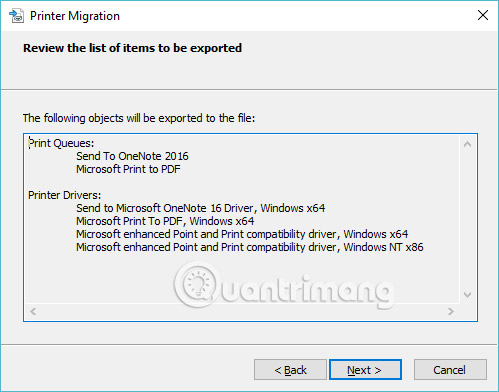
Select Export printer queues and printer drivers into a file and click Next. Select This print server and click Next twice.
Click Browse . to select where you want to save the .printerExport file. When ready, click Next, then click Finish.
Store printer settings
Press the Windows + R key, enter PrintBrmUi.exe and click OK.
Select Import printer queues and printer drivers from a file . Click Next, then click Browser . and locate the backup file you created earlier. Click Next.
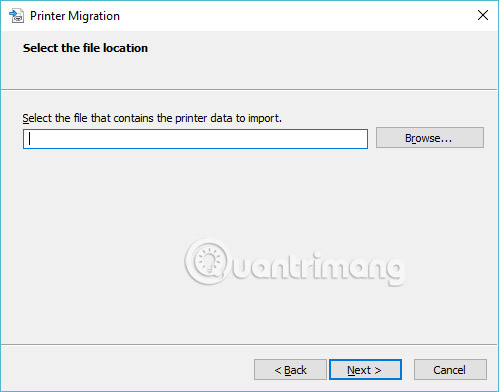
Review the list of items to import and click Next. Select This print server and click Next.
Use the Import mode menu to choose between Keep existing printers or Overwrite existing printers . The following option is probably the choice you want, but read the descriptions for each option.
Click Next, then click Finish and you're done.
4. Windows Registry
The Registry is a database of settings for Windows, hardware, applications, users and more. It can be a powerful tool to configure your computer, but it is important not to edit anything in the Registry. To keep yourself safe, make sure you back up your Registry, at least before making any changes to it.
To start, press the Windows + R key to open Run. Enter regedit and click OK. This will open the Registry Editor.
Backup Windows Registry
To backup the entire Registry, right-click Computer in the left panel and click Export. Navigate to where you want to place your backup, enter the file name and click Save.
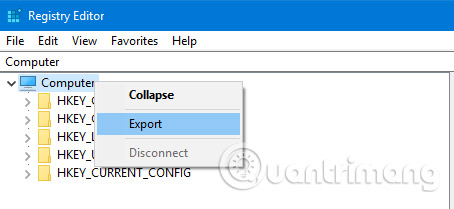
You can also backup specific Registry folders instead of the whole. To do so, use the instructions above, but replace Computer with any directory.
Restore printer settings
To restore, open the Registry Editor and go to File > Import . Navigate to the location where the backup file is located and double-click it.
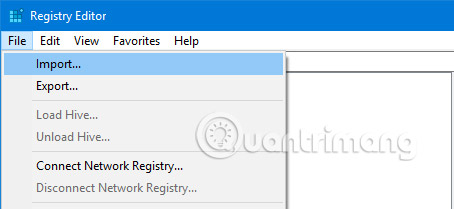
Whether you use third-party software to back up or use useful tips above, it's important that you are actually backing up your data. Don't hesitate. Protect yourself from possible troubles in the future.
You should not back up only your Windows applications. You should also take steps to back up your Outlook email regularly.
Good luck!
See more:
- Backup and restore installed applications on Android using AppMonster
- How to backup and restore Windows in just 10 minutes with Acronis True Image
- How to backup and restore Windows 10 from System Image
 How to backup Outlook email with File History on Windows 10
How to backup Outlook email with File History on Windows 10 How to hide suggestions on Windows 10 Timeline
How to hide suggestions on Windows 10 Timeline How to set up Google as the default search engine for the Start menu on Windows 10
How to set up Google as the default search engine for the Start menu on Windows 10 7 ways to turn off Windows 10 laptop screen
7 ways to turn off Windows 10 laptop screen Instructions for installing Tails on Windows
Instructions for installing Tails on Windows How to turn off Shared Experience feature in Windows 10
How to turn off Shared Experience feature in Windows 10